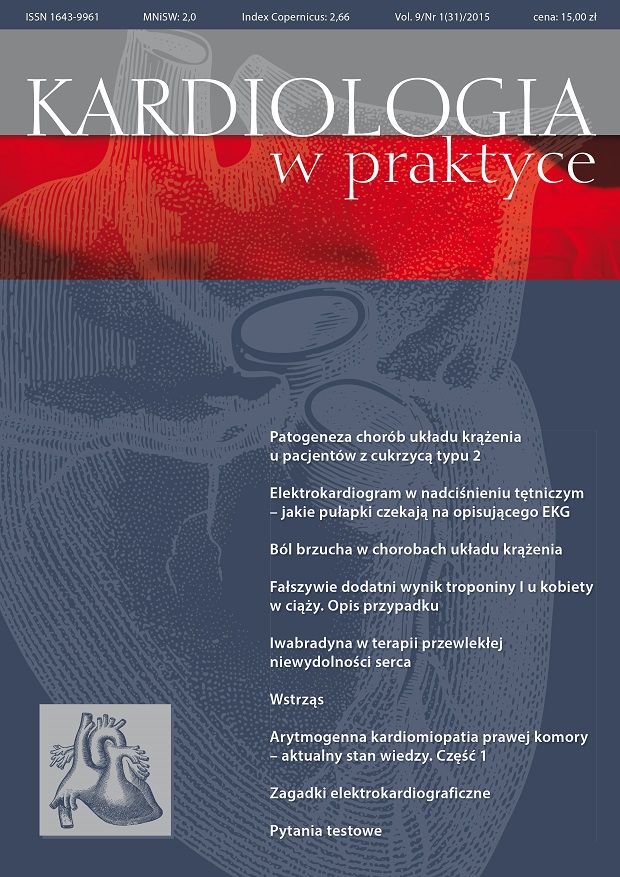Ivabradine for treating chronic heart failure Review article
Main Article Content
Abstract
Heart rate is one of the main parameters assessing cardiovascular system function. It is well known that increased heart rate is a risk factor of general and cardiovascular mortality in different populations. The classical treatment to achieve heart rate reduction by β-blockers and some calcium-channel antagonists may be limited by contraindictions or adverse reactions.
Ivabradine is a novel pharmacological agent able to slow heart rate without complicating side effects. It acts by inhibiting If ion channels of the sinoatrial node.
The reduction of heart rate by ivabradine has been characterised in several human studies involving healthy volunteers and patients, and in several pooled analyses of data from multiple studies such as BEAUTIFUL, ASSOCIATE, SHIFT and SIGNIFY.
Downloads
Article Details

This work is licensed under a Creative Commons Attribution-NonCommercial 4.0 International License.
Copyright: © Medical Education sp. z o.o. This is an Open Access article distributed under the terms of the Attribution-NonCommercial 4.0 International (CC BY-NC 4.0). License (https://creativecommons.org/licenses/by-nc/4.0/), allowing third parties to copy and redistribute the material in any medium or format and to remix, transform, and build upon the material, provided the original work is properly cited and states its license.
Address reprint requests to: Medical Education, Marcin Kuźma (marcin.kuzma@mededu.pl)
References
2. Sethi D., Wood S., Mitis F. et al.: WHO Regional Office for Europe – European report on preventing elder maltreatment 2011: 1-100.
3. Wożakowska-Kapłon B., Mamcarz A., Filipiak K.J.: Iwabradyna w terapii niewydolności serca – od teorii do praktyki. Medical Education, Warszawa 2014.
4. Bleumink G.S., Knetsch A.M., Sturkenboom M.C. et al.: Quantifying the heart failure epidemic: prevalence, incidence rate, lifetime risk and prognosis of heart failure The Rotterdam Study. Eur. Heart J. 2004; 25(18): 1614-1619.
5. Kasprzak J.D., Stępińska J., Wożakowska-Kapłon B. et al.: Optymalna częstość rytmu serca – aktualny cel terapii kardiologicznej. Stanowisko grupy ekspertów Sekcji Farmakoterapii Sercowo Naczyniowej Polskiego Towarzystwa Kardiologicznego. Kardiologia Polska 2012; 70(10): 1081-1094.
6. Levine H.J.: Rest heart rate and life expectancy. J. Am. Coll. Cardiol. 1997; 30: 1104-1106.
7. Dyer A.R., Persky V., Stamler J. et al.: Heart rate as a prognostic factor for coronary heart disease and mortality: findings in three Chicago epidemiologic studies. Am. J. Epidemiol. 1980; 112: 736-749.
8. Kannel W.B., Kannel C., Paffenberger R.S. Jr et al.: Heart rate and cardiovascular mortality: the Framingham study. Am. Heart J. 1987; 113: 1489-1494.
9. Heidland U., Strauer B.: Left ventricular muscle mass and elevated heart rate are associated with coronary plague disruption. Circulation 2001; 104: 1477-1482.
10. DiFrancesco D., Camm J.A.: Heart rate lowering by specific and selective I(f) current inhibition with ivabradine: a new therapeutic perspective in cardiovascular disease. Drugs 2004; 64: 1757-1765.
11. Accili E., Proenza C., Baruscotti M. et al.: From funny current to HCN channel: 20 years of excitation. News Physiol. Sci. 2002; 17: 32-37.
12. DiFrancesco D., Tortora P.: Direct activation of cardiac pacemaker channels by intracellural cyclic AMP. Nature 1991; 351: 145-147.
13. DiFrancesco D.: Pacemaker mechanisms in cardiac tissue. Ann. Rev. Physiol. 1993; 55: 455-472.
14. Bucchi A., Tognati A., Milanesi R. et al.: Current-dependent block of rabbit sino-atrial node I(f) channels by ivabradine. J. Gen. Physiol. 2002; 120: 1-15.
15. Thollon C., Bidouard J.P., Cambarrat C. et al.: Stereospecific in vitro and in vivo effects of the new sinus node inhibitor (+)-S 16257. Eur. J. Pharmacol. 1997; 339(1): 43-51.
16. Simon L., Ghaleh B.: Puybasset L. et al.: Coronary and hemodynamic effects of S 16257, a new bradycardic agent, in resting and exercising conscious dogs. J. Pharmacol. Exp. Ther. 1995 ; 275(2): 659-666.
17. Colin P., Ghaleh B., Hittinger L. et al.: Differential effects of heart rate reduction and beta-blockade on left ventricular relaxation during exercise. Am. J. Physiol. Heart Circ. Physiol. 2002; 282(2): H672-679.
18. Berdeaux A.: Preclinical results with I(f) current inhibition by ivabradine. Drugs 2007; 67(supl. 2): 25-33.
19. Charakterystyka produktu leczniczego Procoralan [online: http://leki.urpl.gov.pl/files/Procoralan_tablpowl.pdf].
20. De Ferrari G.M., Mazzuero A., Agnesina L. et al.: Favourable effects of heart rate reduction with intravenous administration of ivabradine in patients with advanced heart failure. Eur. J. Heart Fail. 2008; 10(6): 550-555.
21. Borer J., Fox K., Jaillon P. et al.: Antianginal and antiischemic effects of ivabradine, an I(f) inhibitor, in stable angina: a randomized, double-blind, multicentered, placebo-controlled trial. Circulation 2003; 107: 817-823.
22. Swedberg K., Komajda M., Böhm M. et al.: Ivabradine and outcomes in chronic heart failure (SHIFT): a randomised placebo-controlled study. Lancet 2010; 376(9744): 875-885.
23. Swedberg K., Komajda M., Böhm M. et al.: Rationale and design of a randomized, double-blind, placebo-controlled outcome trial of ivabradine in chronic heart failure: the Systolic Heart Failure Treatment with the I(f) Inhibitor Ivabradine Trial (SHIFT). Eur. J. Heart Fail. 2010; 12(1): 75-81.
24. Beautiful Study Group: Ferrari R., Ford I., Fox K. et al.: The BEAUTIFUL study: randomized trial of ivabradine in patients with stable coronary artery disease and left ventricular systolic dysfunction – baseline characteristics of the study population. Cardiology 2008; 110(4): 271-282.
25. Tardif J.C., Ponikowski P., Kahan T. et al.: Effects of ivabradine in patients with stable angina receiving β-blockers according to baseline heart rate: an analysis of the ASSOCIATE study. Int. J. Cardiol. 2013; 168(2): 789-794.
26. Tardif J.C., O’Meara E., Komajda M. et al.: Effects of selective heart rate reduction with ivabradine on left ventricular remodelling and function: results from the SHIFT echocardiography substudy. Eur. Heart J. 2011; 32(20): 2507-2515.
27. Fox K., Ford I., Steg P.G. et al.: Ivabradine in Stable Coronary Artery Disease without Clinical Heart Failure. N. Engl. J. Med. 2014; 371(12): 1091-1099.

